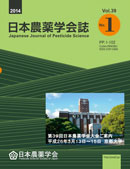Volume 39, Issue 1
Displaying 1-18 of 18 articles from this issue
- |<
- <
- 1
- >
- >|
-
2014Volume 39Issue 1 Pages 1-9
Published: 2014
Released on J-STAGE: August 26, 2014
Download PDF (467K) -
2014Volume 39Issue 1 Pages 10-17
Published: 2014
Released on J-STAGE: August 25, 2014
Download PDF (306K)
-
2014Volume 39Issue 1 Pages 18-31
Published: 2014
Released on J-STAGE: August 25, 2014
Download PDF (658K)
-
2014Volume 39Issue 1 Pages 32
Published: 2014
Released on J-STAGE: August 26, 2014
Download PDF (152K) -
2014Volume 39Issue 1 Pages 33-40
Published: 2014
Released on J-STAGE: August 25, 2014
Download PDF (1757K) -
2014Volume 39Issue 1 Pages 41-47
Published: 2014
Released on J-STAGE: August 25, 2014
Download PDF (750K) -
2014Volume 39Issue 1 Pages 48-52
Published: 2014
Released on J-STAGE: August 25, 2014
Download PDF (409K) -
2014Volume 39Issue 1 Pages 53-57
Published: 2014
Released on J-STAGE: August 25, 2014
Download PDF (562K) -
2014Volume 39Issue 1 Pages 58-62
Published: 2014
Released on J-STAGE: August 25, 2014
Download PDF (247K) -
2014Volume 39Issue 1 Pages 63-67
Published: 2014
Released on J-STAGE: August 25, 2014
Download PDF (1051K) -
2014Volume 39Issue 1 Pages 68
Published: 2014
Released on J-STAGE: August 27, 2014
Download PDF (107K) -
2014Volume 39Issue 1 Pages 69-77
Published: 2014
Released on J-STAGE: August 25, 2014
Download PDF (1462K) -
2014Volume 39Issue 1 Pages 78-82
Published: 2014
Released on J-STAGE: August 25, 2014
Download PDF (1421K) -
2014Volume 39Issue 1 Pages 83-88
Published: 2014
Released on J-STAGE: August 25, 2014
Download PDF (631K) -
2014Volume 39Issue 1 Pages 89-95
Published: 2014
Released on J-STAGE: August 25, 2014
Download PDF (525K)
-
2014Volume 39Issue 1 Pages 96-98
Published: 2014
Released on J-STAGE: August 25, 2014
Download PDF (226K) -
2014Volume 39Issue 1 Pages 99-100
Published: 2014
Released on J-STAGE: August 25, 2014
Download PDF (192K)
-
2014Volume 39Issue 1 Pages 101
Published: 2014
Released on J-STAGE: August 25, 2014
Download PDF (38K)
- |<
- <
- 1
- >
- >|
